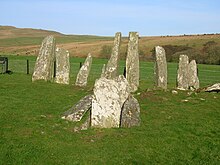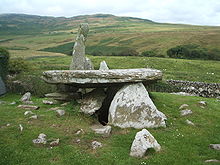Cairnholy
Cairnholy in the south of Dumfries and Galloway , Scotland |
The megalithic complexes of Cairnholy (I + II) are 150 m apart on a slope above the Kirkdale Gorge east of Carsluith on Wigtown Bay in Dumfries and Galloway in Scotland . The sites are above Kirkdale on the A75 .
They are relatively well-preserved complexes of the Clyde Tomb type, the stone mounds of which were removed, but have now been restored. There are numerous prehistoric monuments in the surrounding hills. The two 5000 year old complexes are among the earliest monuments in the area. In addition to other Cairns ( Cairnderry ), menhirs , stone circles and cup-and-ring markings are represented.
Cairnholy I
Eight tall, slender stones of the slightly concave exedra and many stones of the chamber are preserved. The two on the three meter high portal steles are particularly noticeable. They formed the entrance to the chamber, which was sealed off by a tall, narrow locking stone, for which there was a hole in the floor for anchoring. Today the lock stone lies overturned between the portal steles. The cairn was originally about 43 meters long and ten meters wide. The trapezoidal stone mound that covered the chamber is oriented west-east. The chamber consisted of two areas; the part further back was also separated from the area closer to the entrance by a lock stone.
Finds
During the excavations in 1949 by Stuart Piggott and Thomas George Eyre Powell , no burials were found because the bones had dissolved in the acidic soil. Some grave goods could be recovered. The most important are the part of an ax, made of green jadeite , which comes from the Alps, and a leaf-shaped arrowhead. These additions come from the front part of the chamber. There were also fragments of pottery here. The rim of a vessel was discovered in the hole for the lock stone. At the time of the excavation, only a few remains of grave goods could be found in the rear chamber section, including fragments of containers and a stone with a cup-and-ring mark and six concentric rings.
The forecourt of the tomb was used for ritual ceremonies. Prior to the north of the entrance part of the lying Exedra were of a flat vessel and into the vicinity of a small hearth parts tee from pitchstone discovered that from the Isle of Arran originates. The hearth was later covered with earth in which the remains of four smaller hearths were found. It has not yet been possible to determine how long the distance between the fireplaces was. A stone plinth on the border of the forecourt opposite the two portal steles marks another fireplace.
Construction phases
The inaccessible rear compartment of the chamber, which can also be found in the Cairnholy II grave complex, indicates that the complex was built in at least two phases. The inner part of the chamber is the older and it is believed that it was originally built as a stone box in a smaller cairn . This was then expanded by adding a second chamber and covering it with stones.
The 1.5 m high locking stone between the rear and the front part of the chamber is considerably higher than the side plates of the chamber and makes access from the entrance area impossible. Grahem Ritchie found that the early round cairns in Scotland could only have been accessed again by removing the upper part of the cairn and lifting the capstone. Many of these facilities were later expanded and given a facade and a high entrance. A chamber that can be entered from this entrance, which was mostly also paved, and the construction of a forecourt indicate a changed use of the enlarged monuments.
During his excavation, Piggott cut a section through the base of the monument at right angles to its axis. It turned out that in the outer part of the cairn apparently different, smaller stones had been used than in the inner part. At the boundary between these two types of rock, larger, inwardly sloping stones were found, which today are interpreted as the delimitation of an inner component. The outer curbs were found in an outwardly sloping position.
The Cairnholy finds, including the jadeite ax, are kept in the Royal Museum in Edinburgh .
Cairnholy II
A structure very similar to Cairnholy I, but smaller, is Cairnholy II. This Cairn also contained a two-part burial chamber. Except for the hill that has gone out, this grave is well preserved. One of the two portal stones broke, there was no megalithic facade like that of Cairnholy I. Cairnholy II is located on an elevation around 150 m from the neighboring Cairn. It may be that this remarkable landmark, visible from afar, gave rise to the local tradition of associating the tomb with the mythical Scottish King Galdus . However, this legend is also for the nearby stone circle of Torhouse .
literature
- Rodney Castleden: The Stonehenge People. An exploration of life in Neolithic Britain, 4700-2000 BC. Routledge & Paul, London et al. 1987 ISBN 0-7102-0968-1 , p. 186.
- Vicki Cummings: Building from Memory. Remembering the past at Neolithic monuments in western Britain. In: Howard Williams (Ed.): Archaeologies of remembrance. Death and memory in past societies. Kluwer Academic, New York NY et al. 2003, ISBN 0-306-47451-4 , pp. 25-44, here pp. 29-32.
- Audrey Shore Henshall: The chambered tombs of Scotland. Volume 2. Edinburgh University Press, Edinburgh 1972, ISBN 0-85224-190-9 , pp. 42 and 105.
Web links
Individual evidence
- ↑ Cairnholy ( Memento of the original from March 4, 2016 in the Internet Archive ) Info: The archive link was inserted automatically and has not yet been checked. Please check the original and archive link according to the instructions and then remove this notice. at Scotlands Places Record Page
- ^ Rodney Castleden: Neolithic Britain. New stone age sites of England, Scotland and Wales. Routledge, London et al. 1992, ISBN 0-415-05845-7 , p. 265.
- ^ Jack G. Scott: The Clyde Cairns of Scotland. In: Glyn Daniel, Poul Kjærum (Ed.): Megalithic graves and ritual. Papers presented at the III Atlantic Colloquium, Moesgård 1969 (= Jysk Arkaeologisk Selskabs skrifter. 11). Gyldendalske Boghandel (in comm.), Copenhagen 1973, ISBN 87-00-08861-7 , pp. 117–128.
- ↑ Audrey S. Henshall: Scottish chambered tombs and long mounds. In: Colin Renfrew (ed.): British prehistory. A new outline. Noyes Press, Park Ridge NJ 1974, ISBN 0-8155-5032-4 , pp. 137-164, here pp. 144-146.
- ^ Graham Ritchie: Monuments associated with Burial and Ritual in Argyll. In: Graham Ritchie (Ed.): The Archeology of Argyll. Edinburgh University Press, Edinburgh 1997, ISBN 0-7486-0645-9 , pp. 67-94.
- ^ Gordon Noble: Neolithic Scotland: Timber, Stone, Earth and Fire . Edinburgh University Press, Edinburgh 1997, p. 113 ISBN 0-7486-2338-8
- ^ Stuart Piggott , Thomas GE Powell : The excavation of three Neolithic chambered tombs in Galloway, 1949. In: Proceedings of the Society of Antiquaries of Scotland. Vol. 83, 1948/1949, pp. 103–161, ( digital version (PDF; 6.5 MB) ).
- ^ Stuart Piggott, Thomas GE Powell: The excavation of three Neolithic chambered tombs in Galloway, 1949. In: Proceedings of the Society of Antiquaries of Scotland. Vol. 83, 1948/1949, pp. 103–161, here p. 123, ( digital version (PDF; 6.5 MB) ).
Coordinates: 54 ° 51 '28.1 " N , 4 ° 18' 38.7" W.



